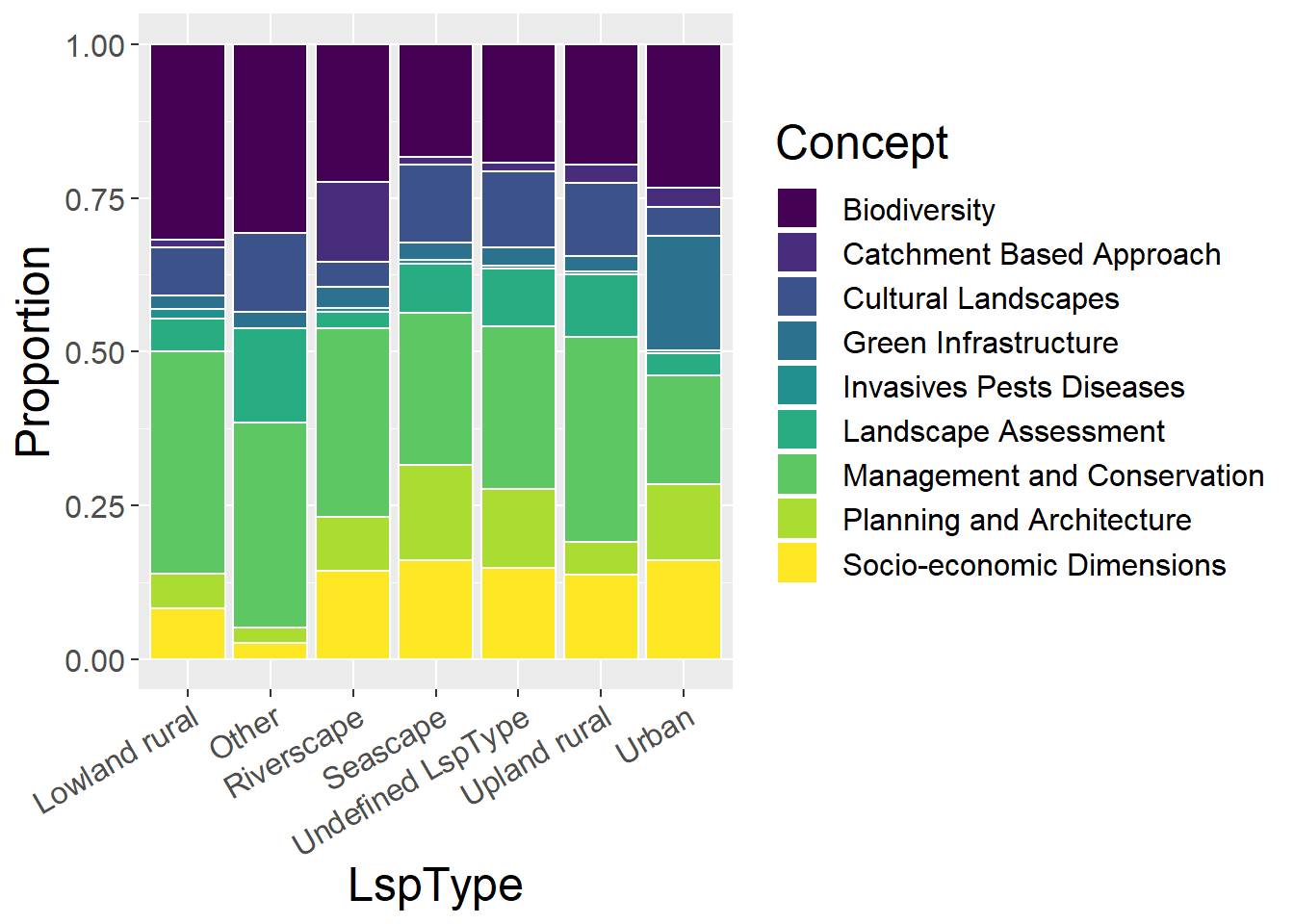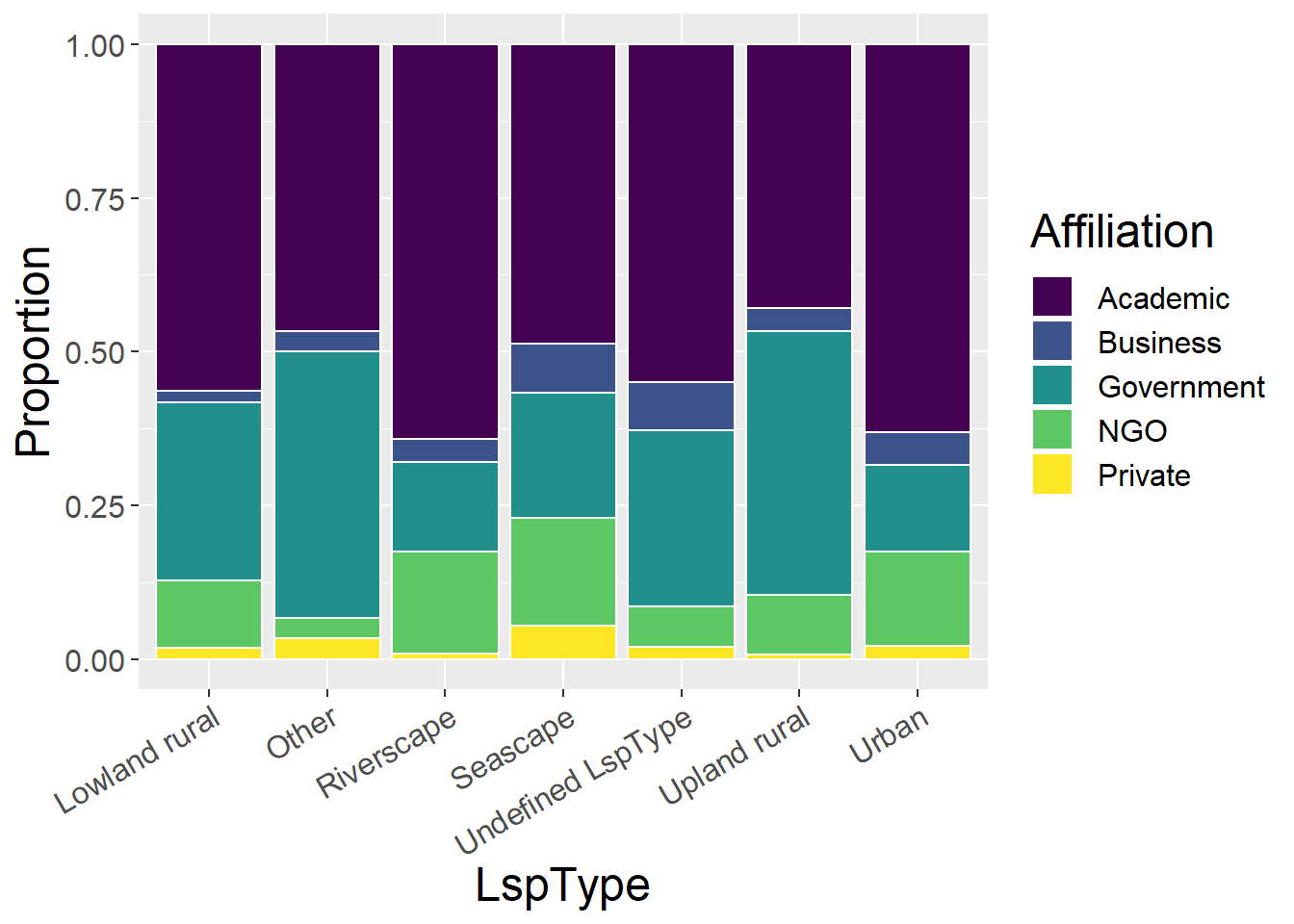Chapter 4 Analysis by Landscape Type
Bar charts and tables to examine how contribution to conferences have changed over time.
4.1 Total Conference Contributions
#spec(cpdata)
lspdata <- cpdata %>%
select_if(is.numeric) %>%
gather(key = LspType, value = count, `Upland rural`:Other) %>%
filter(count > 0) %>%
group_by(`LspType`) %>%
summarise_all(sum, na.rm=T) General observations:
- Lowland rural dominate, followed by ‘undefined’ and Upland rural
lspdata %>%
select(LspType, count) %>%
mutate(prop = count/sum(count)) %>%
mutate(prop = round(prop,3)) %>%
kable() %>%
kable_styling() %>%
scroll_box(width = "100%")| LspType | count | prop |
|---|---|---|
| Lowland rural | 363 | 0.406 |
| Other | 26 | 0.029 |
| Riverscape | 96 | 0.108 |
| Seascape | 68 | 0.076 |
| Undefined LspType | 136 | 0.152 |
| Upland rural | 114 | 0.128 |
| Urban | 90 | 0.101 |
ggplot(lspdata, aes(x=LspType, y=count)) +
geom_bar(stat="identity") +
geom_text(aes(x=LspType, y=max(count), label = paste0(round(100*count / sum(count),1), "%"), vjust=-0.25)) +
theme(axis.text.x = element_text(angle = 30, hjust = 1))
4.3 Organism
General observations:
- Animal types quite evenly distributed across Lowland rural
- Humans are large contributor to seascape studies (possibly by absolute number as well as relative)
- Generic habitat is large contributor across all landscape types
sppCounts <- lspdata %>%
select(LspType,Mammals, Humans, Birds, Reptiles, Inverts, Plants, Amphibians, Fish, `Generic Habitat`,`Woodland Forests`) %>%
mutate(sum = rowSums(.[2:11])) %>% #calculate total for subsquent calcultation of proportion
gather(key = Type, value = count, -LspType, -sum) %>%
mutate(prop = count / sum) #calculate proportion
ggplot(sppCounts, aes(x=LspType, y=count, fill=Type)) + geom_bar(stat="identity", colour="white") +
scale_fill_viridis(discrete = TRUE) +
theme(axis.text.x = element_text(angle = 30, hjust = 1)) +
labs(fill="Organism", y = "Abstract Count")
ggplot(sppCounts, aes(x=LspType, y=prop, fill=Type)) + geom_bar(stat="identity", colour="white") +
scale_fill_viridis(discrete = TRUE) +
theme(axis.text.x = element_text(angle = 30, hjust = 1)) +
labs(fill="Organism", y = "Proportion")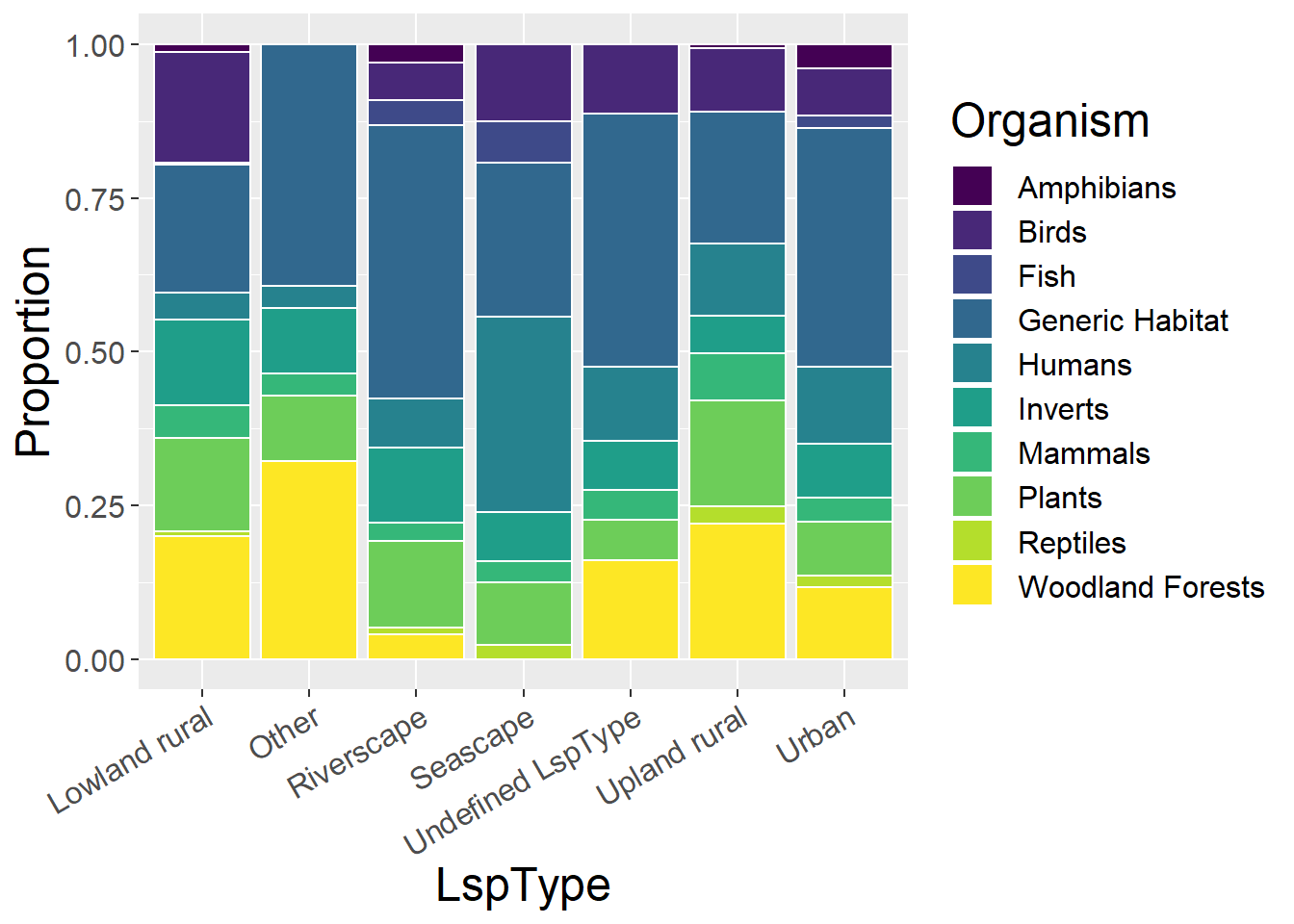
4.4 Methods
General observations:
- ‘Undefined landscape’ studies are largely theoretical
- Lowland rural largely studies using empirical and quantitative methods
- Seascape studies have largest proportion of qualitative methods
methodsCounts <- lspdata %>%
select(LspType,Empirical, Theoretical, Qualitative, Quantitative, GIS, `Remote sensing`) %>%
mutate(sum = rowSums(.[2:7])) %>% #calculate total for subsquent calcultation of proportion
gather(key = Type, value = count, -LspType, -sum) %>%
mutate(prop = count / sum) #calculate proportion
ggplot(methodsCounts, aes(x=LspType, y=count, fill=Type)) + geom_bar(stat="identity", colour="white") +
scale_fill_viridis(discrete = TRUE) +
theme(axis.text.x = element_text(angle = 30, hjust = 1)) +
labs(fill="Method", y = "Abstract Count")
ggplot(methodsCounts, aes(x=LspType, y=prop, fill=Type)) + geom_bar(stat="identity", colour="white") +
scale_fill_viridis(discrete = TRUE) +
theme(axis.text.x = element_text(angle = 30, hjust = 1)) +
labs(fill="Method", y = "Proportion")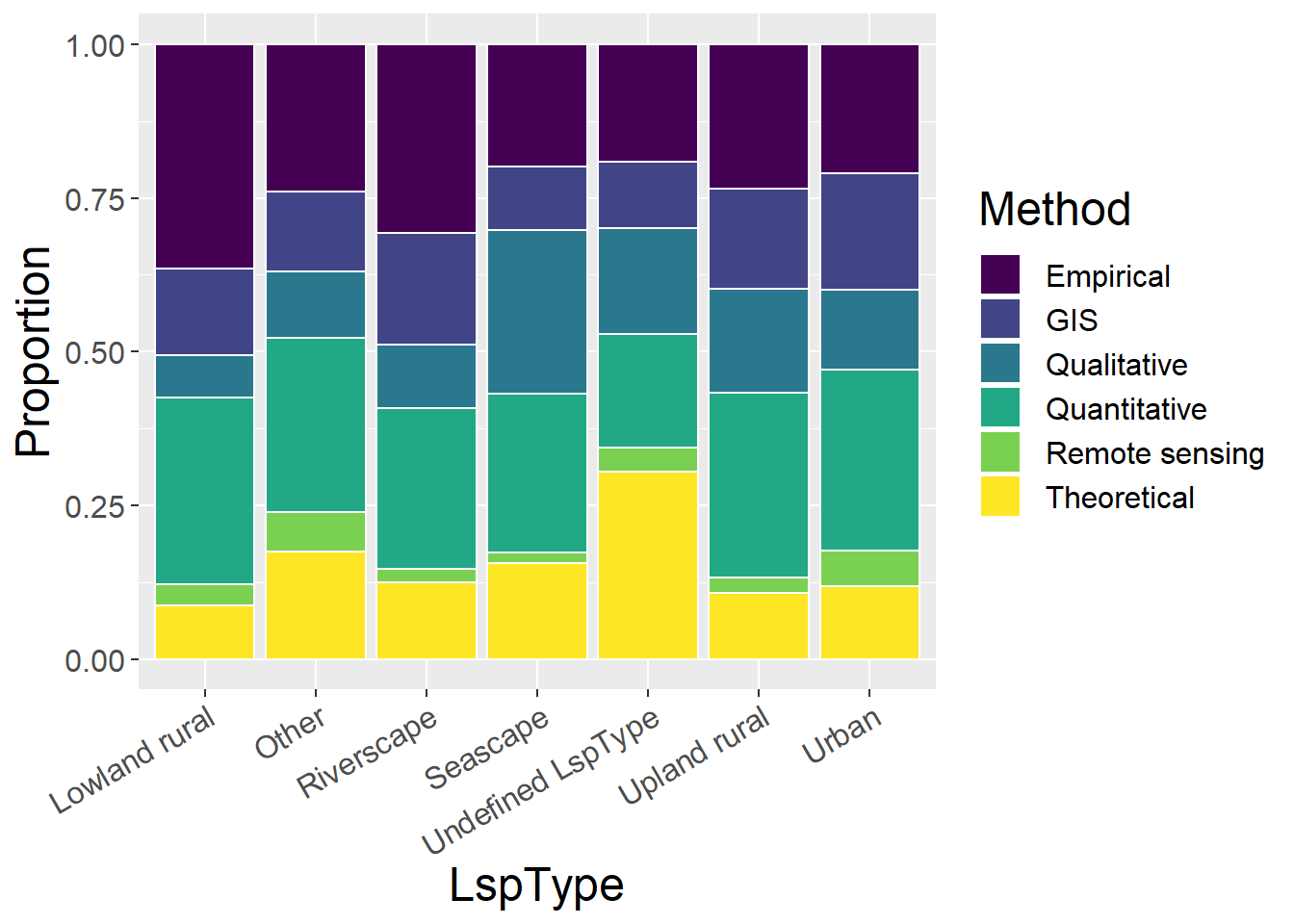
4.5 Spatial Extent
General observations:
- Urban landscape studies are dominated by Local scale analysis
- Upland rural have larger proportion of national studies than Lowland rural
spatialCounts <- lspdata %>%
select(LspType,Micro, Mini, Local, Regional, National, Continental, Global,`Undefined Extent`) %>%
mutate(sum = rowSums(.[2:9])) %>% #calculate total for subsquent calcultation of proportion
gather(key = Type, value = count, -LspType, -sum) %>%
mutate(prop = count / sum) #calculate proportion
factor_order <- c('Micro', 'Mini', 'Local', 'Regional', 'National', 'Continental', 'Global','Undefined Extent')
factor_labels <- c('Micro', 'Mini', 'Local', 'Regional', 'National', 'Continental', 'Global','Undefined')
ggplot(spatialCounts, aes(x=LspType, y=count, fill=factor(Type, level=factor_order))) + geom_bar(stat="identity", colour="white") +
scale_fill_viridis(discrete = TRUE) +
theme(axis.text.x = element_text(angle = 30, hjust = 1)) +
labs(fill="Extent", y = "Abstract Count")
ggplot(spatialCounts, aes(x=LspType, y=prop, fill=factor(Type, level=factor_order))) + geom_bar(stat="identity", colour="white") +
scale_fill_viridis(discrete = TRUE) +
theme(axis.text.x = element_text(angle = 30, hjust = 1)) +
labs(fill="Extent", y = "Proportion")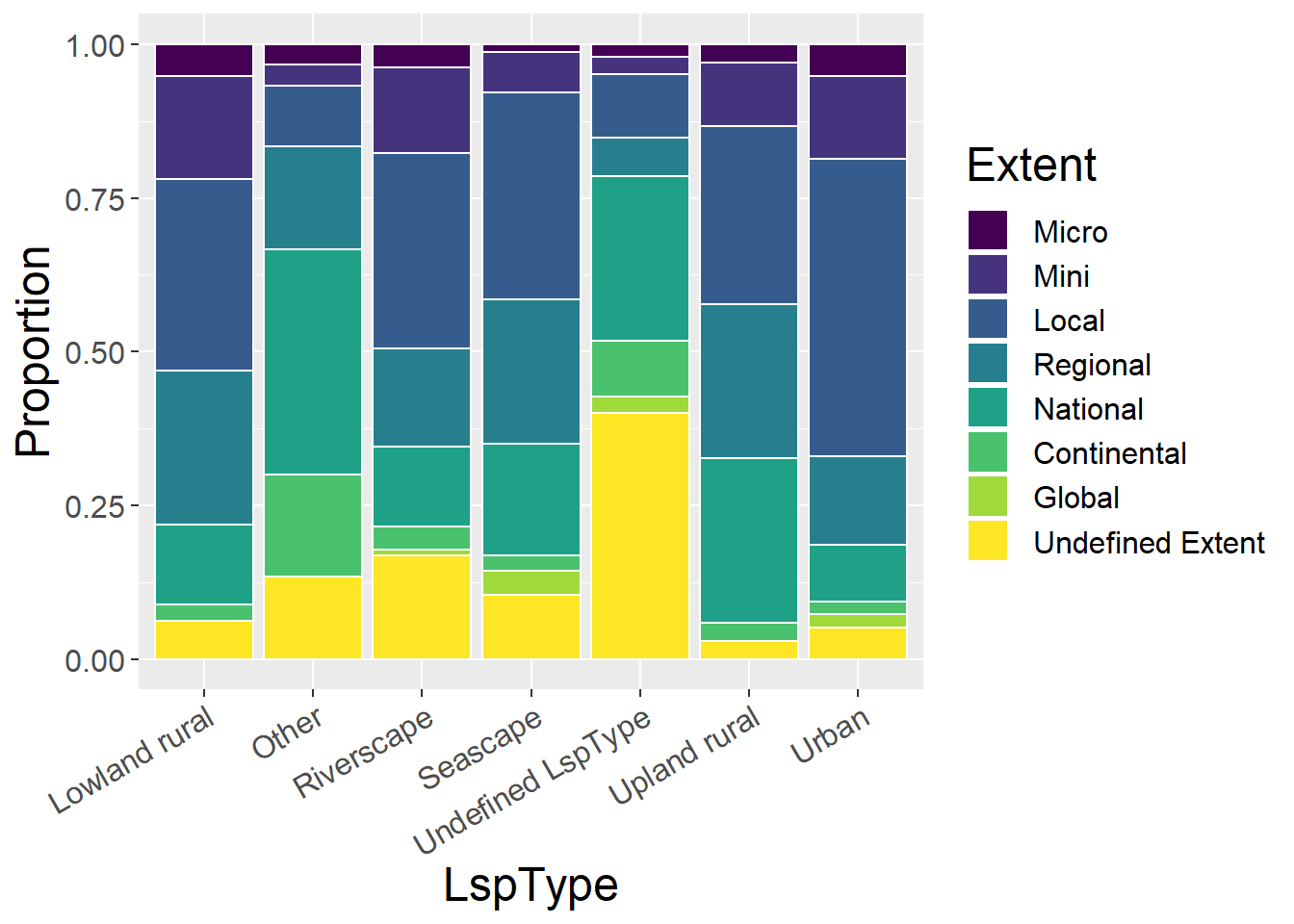
4.6 Temporal Extent
General observations:
- Upland have greatest proportion of Decadal studies
- Urban have greatest proportion of Monthly studies
temporalCounts <- lspdata %>%
select(LspType,Hours, Days, Weeks, Months, Years, Decades, Centuries, Longer, `Undefined Temporal`) %>%
mutate(sum = rowSums(.[2:10])) %>% #calculate total for subsquent calcultation of proportion
gather(key = Type, value = count, -LspType, -sum) %>%
mutate(prop = count / sum) #calculate proportion
tfactor_order <- c('Hours', 'Days', 'Weeks', 'Months', 'Years', 'Decades', 'Centuries', 'Longer', 'Undefined Temporal')
tfactor_labels <- c('Hours', 'Days', 'Weeks', 'Months', 'Years', 'Decades', 'Centuries', 'Longer', 'Undefined')
ggplot(temporalCounts, aes(x=LspType, y=count, fill=factor(Type, level=tfactor_order))) + geom_bar(stat="identity", colour="white") +
scale_fill_viridis(discrete = TRUE) +
theme(axis.text.x = element_text(angle = 30, hjust = 1)) +
labs(fill="Extent", y = "Abstract Count")
ggplot(temporalCounts, aes(x=LspType, y=prop, fill=factor(Type, level=tfactor_order))) + geom_bar(stat="identity", colour="white") +
scale_fill_viridis(discrete = TRUE) +
theme(axis.text.x = element_text(angle = 30, hjust = 1)) +
labs(fill="Extent", y = "Proportion")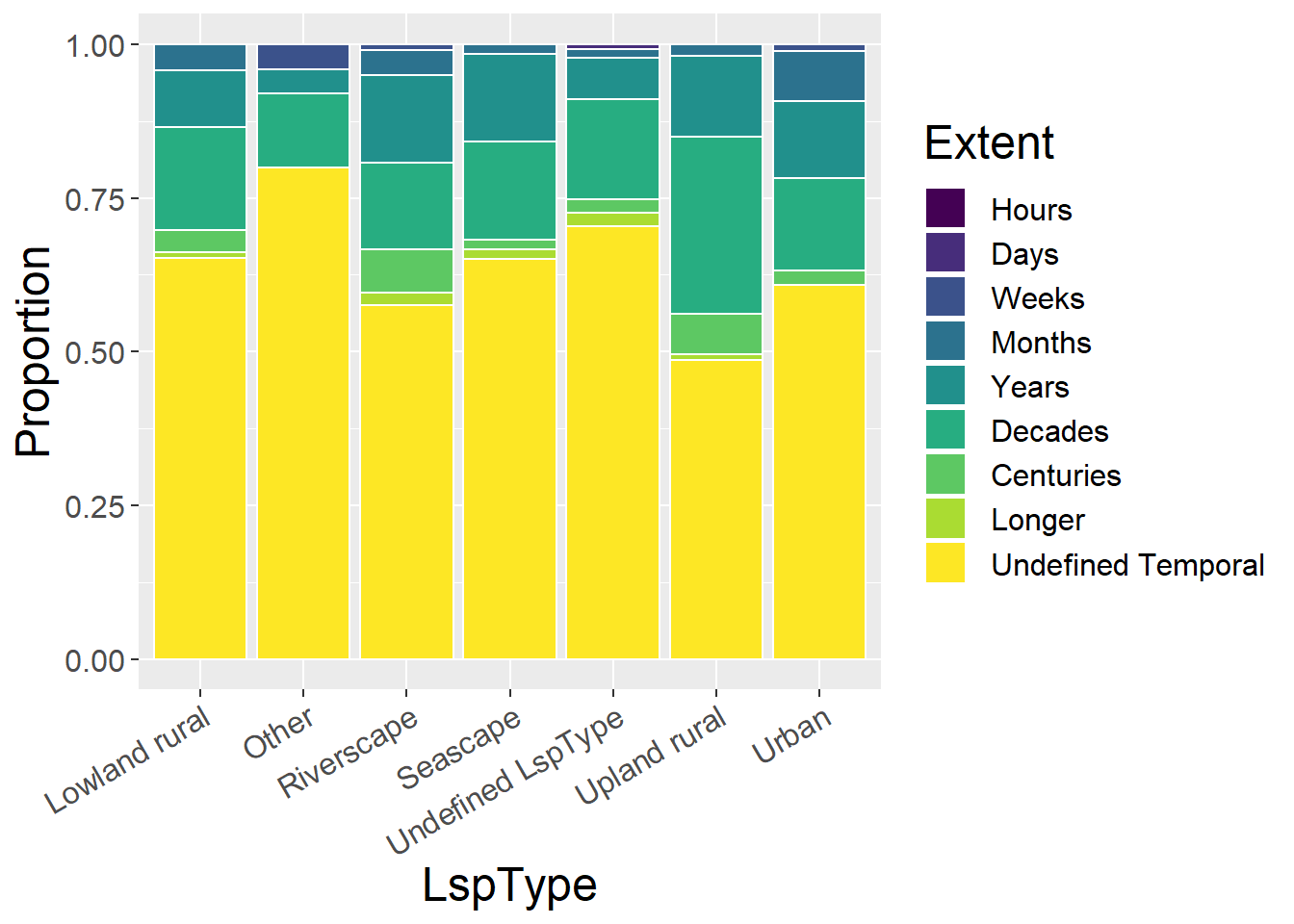
4.7 Concepts
General observations:
- Upland have greatest proportion of LUCC studies
- Seascape have greatest proportion of climate change studies
conceptCounts <- lspdata %>%
select(`LspType`,`PPS of landscapes`,
`Connectivity and fragmentation`, `Scale and scaling`,`Spatial analysis and modeling`,LUCC,`History and legacy`,`Climate change interactions`,`Ecosystem services`,`Landscape sustainability`,`Accuracy and uncertainty`) %>%
mutate(sum = rowSums(.[2:11])) %>% #calculate total for subsquent calcultation of proportion
gather(key = Type, value = count, -`LspType`, -sum) %>%
mutate(prop = count / sum) #calculate proportion
ggplot(conceptCounts, aes(x=`LspType`, y=count, fill=Type)) + geom_bar(stat="identity", colour="white") +
scale_fill_viridis(discrete = TRUE) +
theme(axis.text.x = element_text(angle = 30, hjust = 1)) +
labs(fill="Concept", y = "Abstract Count")
ggplot(conceptCounts, aes(x=`LspType`, y=prop, fill=Type)) + geom_bar(stat="identity", colour="white") +
scale_fill_viridis(discrete = TRUE) +
theme(axis.text.x = element_text(angle = 30, hjust = 1)) +
labs(fill="Concept", y = "Proportion")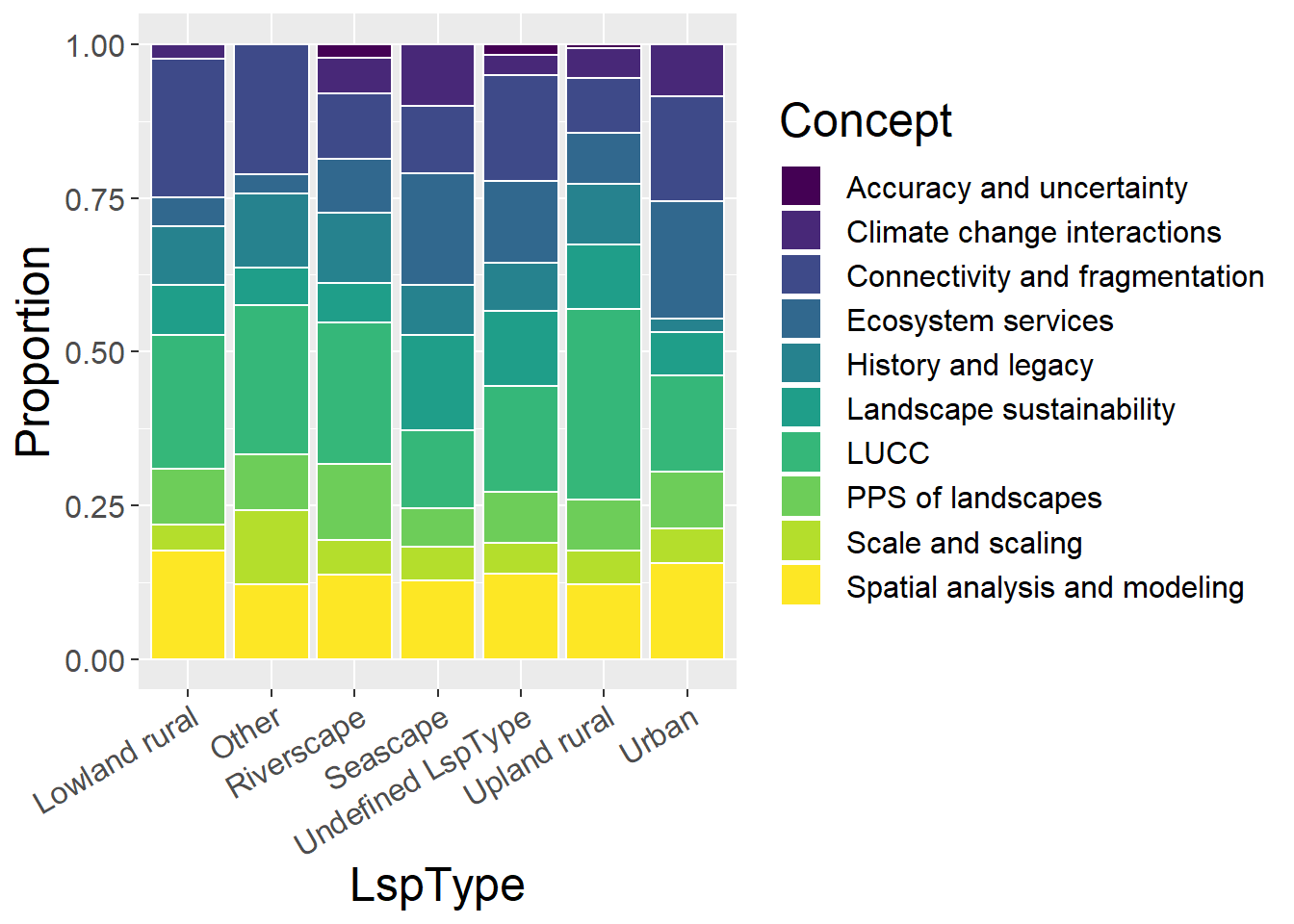
4.8 Other Concepts
General observations:
- Socio-economic dimensions are most widely examined in Urban landscapes and Seascapes
- Unsurprisingly, Green Infrastructure has greatest proportion in Urban landscapes and catchment-based approaches in Riverscapes
- Little study of cultural landscapes in Urban areas
othCCounts <- lspdata %>%
select(`LspType`,`Green Infrastructure`,`Planning and Architecture`,`Management and Conservation`,`Cultural Landscapes`,`Socio-economic Dimensions`,Biodiversity,`Landscape Assessment`,`Catchment Based Approach`,`Invasives Pests Diseases`) %>%
mutate(sum = rowSums(.[2:10])) %>% #calculate total for subsquent calcultation of proportion
gather(key = Type, value = count, -`LspType`, -sum) %>%
mutate(prop = count / sum) #calculate proportion
ggplot(othCCounts, aes(x=`LspType`, y=count, fill=Type)) + geom_bar(stat="identity", colour="white") +
scale_fill_viridis(discrete = TRUE) +
theme(axis.text.x = element_text(angle = 30, hjust = 1)) +
labs(fill="Concept", y = "Abstract Count")
ggplot(othCCounts, aes(x=`LspType`, y=prop, fill=Type)) + geom_bar(stat="identity", colour="white") +
scale_fill_viridis(discrete = TRUE) +
theme(axis.text.x = element_text(angle = 30, hjust = 1)) +
labs(fill="Concept", y = "Proportion")